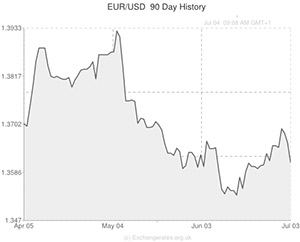
Euro to USD Drops after US Employment Jump
The Euro to US Dollar exchange rate flat lined on Thursday as the appeal of the US Dollar was materially supported by impressive US employment figures. Earlier this week the ADP employment change report detailed an increase of 281,000 positions. As economists had only been expecting a gain of 205,000 positions, this report did appear to indicate that the week’s highly-anticipated non-farm payrolls figure would surprise to the upside – and surprise it certainly did.
The Non-Farm Payrolls report surprised even the most optimistic of industry exports when it revealed an employment increase of 288,000 in June. This followed another fairly impressive (and upwardly revised) employment gain of 224,000 in May. The estimated jobs gain of 215,000 was rather tame in comparison with the actual results and this optimistic sign of improving US economic output (following as it did a run of below-forecast fundamentals) bolstered a flagging ‘Greenback’.
USD Bolstered Despite Rate Bets
The US Dollar had previously come under significant pressure as Federal Reserve Chairwoman Janet Yellen asserted that interest rates would be on hold for some time after the final tapering of asset purchases takes place. This news was the first US Dollar-positive result for some time and the EUR/USD and GBP/USD pairings declined as a result. The report prompted a mixture of responses from industry experts, including this remark from economist Rob Wood; ‘This report changes nothing for the tapering outlook. The Fed has, rightly in our view, assumed that underlying momentum remains solid. With monetary policy extremely loose and government cuts easing markedly, US growth should remain strong and employment growth should remain solid. We look for the Fed to continue cutting bond buying by10 billion Dollars at each meeting until stopping purchases in October.’
Euro Weakens as German Manufacturing Orders Slide
On Friday the Euro was feeling the heat as German Factory Orders were shown to have fallen by -1.7% in May month-on-month. Experts had forecast a 1.1% decline. On the year Factory Orders were up 5.5% rather than the 6.0% expected. This followed a positively revised monthly gain of 3.4% and a revised annual increase of 6.6% in April.
The data saw economist Johannes Gareis remark; ‘The decline is mostly due to the strong rebound in April, which was quite surprising. We are still well above the first-quarter average and this suggests the underlying trend of the German industrial sector, and of the German economy, is intact.’
Separate data showed that German construction PMI edged lower in June, falling from 48.1 to 45.5. However, the Eurozone and Germany both recorded a stronger-than-expected Retail Sales PMI for last month.
With US markets closed for the July 4th celebrations, movement in the EUR/USD pairing was a little restrained, although the Euro to US Dollar exchange rate did hit a low of 1.3582, shedding 0.15% on the day
US Dollar (USD) Exchange Rates
[table width=”100%” colwidth=”50|50|50|50|50″ colalign=”left|left|left|left|left”]
Currency, ,Currency,Rate ,
US Dollar, ,Pound Sterling,0.5833,
,Pound Sterling,0.5833,
US Dollar, ,Canadian Dollar,1.0629,
,Canadian Dollar,1.0629, 
US Dollar, ,Euro,0.7359,
,Euro,0.7359,
US Dollar, ,Australian Dollar,1.0694,
,Australian Dollar,1.0694,
US Dollar, ,New Zealand Dollar,1.1443,
,New Zealand Dollar,1.1443,
Canadian Dollar, ,US Dollar ,0.9405,
,US Dollar ,0.9405,
Pound Sterling, ,US Dollar,1.7143,
,US Dollar,1.7143,
Euro, ,US Dollar,1.3589,
,US Dollar,1.3589,
Australian Dollar, ,US Dollar,0.9350,
,US Dollar,0.9350,
New Zealand Dollar, ,US Dollar,0.8739,
,US Dollar,0.8739,
[/table]

Comments are closed.